Monday, January 13th 2020

ASRock to Launch Hyper Quad M.2 PCIe 4.0 Expansion Card
ASRock is looking to launch a PCIe expansion card for all of your M.2 needs. Should you find your current motherboard is already full to the gills with M.2 SSDs, ASRock's Hyper Quad M.2 PCIe expansion card will allow you to increase M.2 vacancy by up to four additional slots (there's an on-off toggle for you to move in the PCB to select the active M.2 SSDs). The card uses the PCIe 4.0 x16 interface to sufficiently feed the four M.2 SSDs (which typically use the PCIe 4x NVMe protocol) with data.
This is a top notch expansion card design, featuring an aluminium cover and a 50 mm fan to cool down all those SSDs' controllers. The cover features 4x 110 mm thermal pads which align with the M.2 mounts on the PCB, thus allowing the aluminium cover to serve as a veritable heatsink and improve operating temperatures. The expansion card is fed by a single 6-pin power connector, and there is an activity LED for quality of life improvements. No word on pricing just yet.
Sources:
ASRock, Guru3D
This is a top notch expansion card design, featuring an aluminium cover and a 50 mm fan to cool down all those SSDs' controllers. The cover features 4x 110 mm thermal pads which align with the M.2 mounts on the PCB, thus allowing the aluminium cover to serve as a veritable heatsink and improve operating temperatures. The expansion card is fed by a single 6-pin power connector, and there is an activity LED for quality of life improvements. No word on pricing just yet.
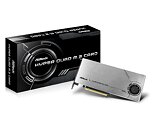
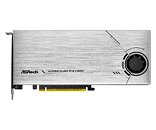
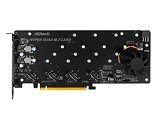
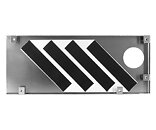
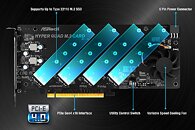
28 Comments on ASRock to Launch Hyper Quad M.2 PCIe 4.0 Expansion Card
They have 64 PCIe lanes. The ASRock TRX40 Creator can run in 16x+16x+8x mode, so you can have a GPU in the 16x and 8x slots and this in another 16x slot. Might be useful to have for video editors that need lots of fast storage i guess.
hardforum.com/threads/build-3970x-dual-2080ti-8tb-m-2-raid-render-monster.1990145/page-3#post-1044435857
It has a pair of these, which are PCIe 3.0 switches.
www.broadcom.com/products/pcie-switches-bridges/pcie-switches/pex8747
They've added a bit of software that allows you to make a fake RAID and that's it.
There's no real CPU offloading, there's as I said, no onboard cache, nor any battery backup, so this is not a hardware RAID card.
It also has one of these, for some reason (SATA support?)
www.marvell.com/documents/xnzfwfktuicdpjakssrh/
Apparently it's not particularly good either.
forums.macrumors.com/threads/highpoint-7102.2172333/page-5?post=27498666#post-27498666
It's also $450, compared to $50-100 for something like the ASRock card.
If you think about it, it's logical - the NVMe connection is the fastest way for data to travel between CPU and storage. Having PCI-E bifurcation - which is required for the M.2 x16 riser cards to work and putting more PCI splitters only adds latency to an already good protocol.
So if your CPU and MB give enough lanes, and you can somehow map each PCI lane to an NVMe drive's lane, it's irrelevant how you make your RAID.
Or did ASRock license it from them or what ?
www.amazon.com/gp/product/B07NQBQB6Z/ref=ppx_yo_dt_b_asin_title_o05_s00?ie=UTF8&psc=1
my mobo bifurcates the lanes, and I still can run 2x gpu @each pcie 3.0 x16, a marvell pcie sata controller, and a pcie soundblaster z card.
I also bought this
www.amazon.com/gp/product/B071S3ZY8P/ref=ppx_yo_dt_b_asin_title_o07_s00?ie=UTF8&psc=1
initially, but it only has room for two drives, and is now a spare host for future use for nvme on boards that support but dont have the physical interface.
The more expensive controller cards do exist that have a bridge chip, hardware raid, and all the bells and whistles, but I dont accept splurging 400$ for them.
I believe the article is incorrect where it describes the DIP switches on the ASRock 4x4 AIC (see above):
ASRock's implementation supports multiple AICs, not merely four M.2 SSDs on a single AIC.
This graphic clearly shows 4 x AICs at lower right:
www.asrock.com/mb/features/Ultra-Quad-M2-Card05.jpg
If anyone is interested in some slightly dated documentation,
ASRock's Tech Support responded very promptly when we
requested documentation for designing a bootable RAID-0 array
on an AMD TR system using this Ultra Quad M.2 card:
supremelaw.org/systems/asrock/X399/Probably NOT: check with the seller, to be sure.
The Gen4 version was only announced very recently, so
there's a good chance the Gen3 version is the one that
is included with the ASRock TRX40 Creator motherboard.
I don't see any AIC in this documentation, just 3 integrated M.2 ports:
images10.newegg.com/BizIntell/item/13/157/13-157-902/PCIeSteel-TRX40%20Creator_112719.jpg
EDIT: found this at Newegg's product page:
"ASRock Hyper M.2 (PCIe Gen4 x4 & SATA3) "
-and-
"M.2 PCI Express module up to Gen4 x4 (64Gb/s)*
* Supports NVMe SSD as boot disks"
Latter is NOT listed under "Accessories" however.
Hope this helps.For desktop systems, a functional substitute for an on-card battery
is a UPS / battery backup for the entire system, of which there are
now many to choose from e.g. APC now offers versions that
output a pure sine wave, instead of a digital "stair-step" approximation.
The one big disadvantage of an OS "software RAID" is that Windows will not boot from such a software RAID.
I can conceive of a way to make an OS software RAID bootable, e.g. by writing config files to a USB thumb drive
and choosing a related option in the motherboard's BIOS: but, MS has chosen NOT to consider such an option.
On the other hand, with so many cores in modern CPUs, an otherwise idle core is available
to do the computation that a dedicated RAID processor performed in older implementations.
Think of "bifurcation" as moving that "dedicated RAID controller" back into the CPU
to perform as a general-purpose central processor.
Re: on-board cache for dedicated RAID controller
See:
www.enmotus.com/midrive
When a RAID-0 array is enabled, the caches that may exist in each M.2 SSD
are effectively summed, to produce a much larger "aggregate" cache.
The MiDrive goes even further by moving most recently used files into SLC,
and moving the least recently used files into QLC.
I expect that we are now seeing only the beginning of extraordinary
engineering possibilities, now that storage vendors have recognized
the upstream potential of x16 expansion slots.